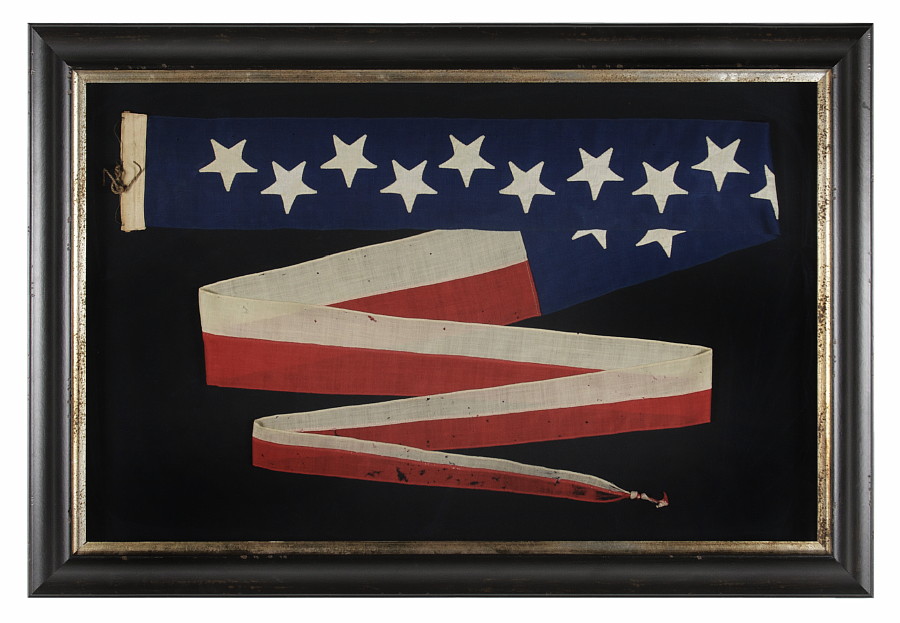
| |
US NAVY COMMISSIONING PENNANT WITH 13 STARS IN A STAGGERED ROW, 1876 ERA, A RARE AND BEAUTIFUL EXAMPLE WITH HAND-SEWN STARS |
|
| Available: |
Sold |
| Frame Size (H x L): |
37.75" x 55.5" |
| Flag Size (H x L): |
|
|
| Description....: |
|
US NAVY COMMISSIONING PENNANT WITH 13 STARS IN A STAGGERED ROW, 1876 ERA, A RARE AND BEAUTIFUL EXAMPLE WITH HAND-SEWN STARS:
Commissioning pennants are the distinguishing mark of a commissioned U.S. Navy ship. A ship became commissioned when this pennant was hoisted. Flown during both times of peace and war, the only time the pennant is not flown is if a flag officer or civilian official is aboard and replaces it with their own flag.
This particular example was made around the time of our nation's centennial of independence (1876). Some have stars in a single, lineal row, while some have 2 rows of stars. Others, like this one, have stars are arranged in long, staggered row. Some commissioning pennants have a forked swallowtail at the extreme fly end. This one simply tapers to a finished point, the tip of which became knotted, which adds an interesting visual effect.
In 18th and early 19th century America, commissioning pennants would typically have a number of stars that reflected the number of official star on the American national flag. As time progressed, more and more states were added, and number of stars was reduced to either 13 stars, to reflect the original number of states, or 7 stars. According to the U.S. Navy, the reason for the choice of 7 stars was not recorded. I have suggested that this number may have been chosen to stand for the 7 seas, but it may just have well have been for some other purpose. Whatever the case may be, after the turn of the 20th century (1900), most pennants had 7 stars.
The 13 stars on this pennant is a star count that not only reflects the 13 original colonies, but also reflects its size. Measuring about 15 feet on the fly, this is the pennant of a small craft. During the 18th and 19th centuries, commissioning pennants were a very important means of identifying and U.S. Navy ship on the open seas. For this reason, they often well-exceed twenty feet, with some reaching as long as one hundred feet. By the 20th century, however, they had become largely ceremonial and customary. Today the largest commissioning pennants measure just two-and-a-half inches by six feet, while some are as short as 4 feet on the fly.
The U.S. Navy flew 13 star flags on small boats, not only in the 18th century, but throughout much or all of the 19th century, particularly the second half. Ship captains were paranoid about the ability of foreign ships to recognize the flag on the open seas. On small flags in particular, viewed through a spyglass at a distance, the ability discern individual stars was of great concern. Keeping the count at 13 maintained better visibility and consistency. The practice theoretically ended in 1916 following an executive order from then-President Woodrow Wilson, though old military traditions die hard and according to at least one expert, Wilson's order did not completely dispel the presence of 13 star flags on U.S. Navy craft.
Construction: The stars are made of cotton, hand-sewn, and double-appliqued. This means that they are sewn to both sides of the pennant. The body of the pennant is made of wool bunting that has been pieced and joined with treadle stitching. There is a twill cotton sleeve along the hoist, through which a wooden dowel was inserted. A length of wire was pieced through the sleeve and affixed to the dowel at the top and bottom, as well as to a brass ring, hand-sewn in the center of the hoist. A length of hemp rope is tied to this same ring and together it and the wire were used to fly the pennant. Some were allowed to spin freely in this manner at the top mast.
Mounting: The pennant has been hand-stitched to 100% cotton, black in color, which was washed to reduce excess dye. An acid-free agent was added to the wash to further set the dye, which was heat-treated for the same purpose. The mount was then placed in a black-painted, hand-gilded and distressed, Italian molding. A shadowbox was created to accommodate soft folds. The glazing is U.V. protective acrylic.
Condition: There is minor mothing and there is loss from wind shear at the fly end from obvious use. This is a remarkably good state of preservation for a 19th century wool example. |
|
|
|
| Collector Level: |
Advanced Collectors and the Person with Everything |
|
| Flag Type: |
Sewn flag |
|
| Star Count: |
13 |
|
| Earliest Date of Origin: |
1870 |
|
| Latest Date of Origin: |
1885 |
|
| State/Affiliation: |
13 Original Colonies |
|
| War Association: |
1866-1890 Indian Wars |
|
| Price: |
SOLD |
|
| |
Views: 3921 |
|
|
|

